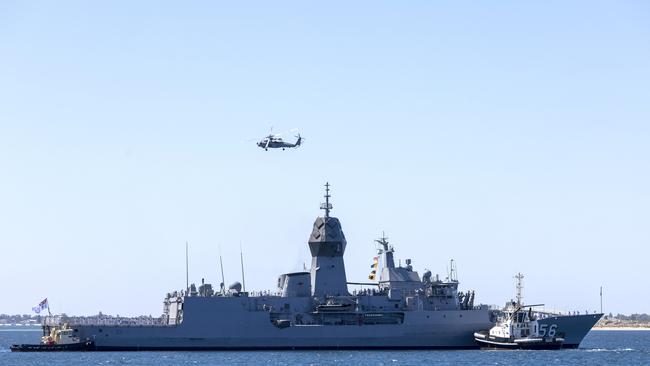Australian Government criticises ‘unsafe and unprofessional’ interaction with Chinese Air Force over Yellow Sea
Canberra has slammed Beijing after a Chinese fighter jet engaged in a risky confrontation with an Australian naval helicopter.
The Australian Government has responded after a Chinese fighter jet engaged in a risky confrontation with an Australian naval helicopter over the Yellow Sea.
Australia has lodged a formal complaint with Beijing following the incident, which saw a People’s Liberation Army Air Force (PLA-AF) aircraft deploy flares across the flight path of the Royal Australian Navy’s MH-60R helicopter.
On May 4th, HMAS Hobart was conducting routine surveillance operations in international waters as part of Operation Argos, which supports the enforcement of United Nations Security Council sanctions against North Korea.
The PLA-AF jet intercepted the Australian helicopter in a manoeuvre described by Australian officials as both “unsafe and unprofessional”.
Although the incident did not result in any injuries to the crew or damage to the helicopter, it raised serious concerns about the safety of Australian Defence Force (ADF) personnel.
The Defence Ministry warned incidents like these could jeopardise the longstanding international agreement of safety and professionalism in military conduct.
“This was an unsafe manoeuvre, which posed a risk to the aircraft and personnel,” the ADF said in a statement on Monday.
“While there were no injuries sustained by ADF personnel or damage caused to the MH-60R helicopter, the safety and wellbeing of our ADF personnel continues to be our utmost priority.
“Australia expects all countries, including China, to operate their militaries in a professional and safe manner.”

The Australian Defence Ministry reaffirmed its commitment to upholding international law, underscoring the right to freedom of navigation and overflight in international waters and airspace.
The Ministry also reiterated its expectation that all nations, including China, adhere to these principles, ensuring their military operations do not pose risks to human life and are conducted responsibly.
This incident adds to a growing list of confrontations involving Chinese military forces and vessels from other countries as tensions continue to mount in the region.
“It’s in character with the way the Chinese have been behaving,” Mr Sheridan said on Sky News on Monday evening, describing the incident as “profoundly disturbing”.
“But as I understand it, our naval presence there is in pursuit of the United Nations’ resolution authorised by the United Nations, in what is indisputably international waters.”
Similarly tense incidents have soured the waters between the two nations, with HMAS Toowoomba reportedly being disabled in “international waters inside of Japan’s Exclusive Economic Zone” in the East China Sea in November.
Despite acknowledging the frigate had Aussie naval divers in the water to untangle a fishing net from its propellers, a Chinese warship continued to approach before activating its sonar.
Naval divers reportedly suffered injuries to their ears in the potentially fatal incident.
At the time, China accused HMAS Toowoomba of “posing a threat” to China’s fishing boats, “provoking” Chinese warships and intruding on Chinese territorial waters.

Australia warned: ‘Be careful’
It came after Beijing warned Australia to “be careful” against acting on its “unwarranted anxieties toward China”, questioning how relations can improve while Canberra accuses it of coercion.
In an April opinion piece published by Chinese government mouthpiece the Global Times, Beijing lamented that despite a significant thawing in the bilateral relationship, Australia’s newly published defence strategy undermined the inroads so far made on trade.
China also accused Canberra of falling victim to the Washington-led “imaginary war with China”, warning that Australia’s US-aligned defence strategy posed an “extreme danger” that would increase risks in the long run.
The warning came after it was revealed Australia’s defence budget would increase by $50bn over the next decade in a bid to counter China’s “coercive tactics” and the growing risk of regional conflict.

The strategy found the strategic environment had deteriorated over the past year, pointing to a rising risk of conflict in the Indo-Pacific as China builds up its military capabilities.
“The risk of a crisis or conflict in the Taiwan Strait is increasing, as well as at other flashpoints, including disputes in the South and East China Seas and on the border with India,” the strategy said.
“In line with its growing strategic and economic weight, China is improving its capabilities in all areas of warfare at a pace and scale not seen in the world for nearly a century.”
A day after a Chinese government spokesman told Australia to “abandon the Cold War mentality”, the Global Times piece went further, saying the strategy was a “serious miscalculation” of the situation in the Asia-Pacific region and a “misjudgment of China’s strategic intentions”.
“China and Australia have no historical grudges or fundamental conflicts of interest, and China has no intention of treating Australia as an enemy, but it is always described as a “threat” by Australia,” the piece said.
Originally published as Australian Government criticises ‘unsafe and unprofessional’ interaction with Chinese Air Force over Yellow Sea





